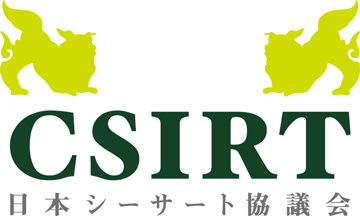Joint Workshop on Security 2008, Tokyo 開催記録サイト
日本シーサート協議会は、JFIRST2008運営委員会(FIRSTに加盟する10チームから構成される委員会)が主催した Joint Workshop on Security 2008, Tokyo(以下、JWS2008)の主旨に賛同し、JWS2008 の開催記録サイトとして協力をしています。 日本シーサート協議会では、今後も、CSIRT活動をより多くの方に伝えるために、CSIRT活動記録の支援を行っていく予定です。
開催概要
2008年3月25日(火)~26日(水)
JWS2008は、日本国内において、CSIRT間の強い信頼関係に基づいた迅速かつ最適な体制作りを推進するための意見交換の場となることを目指したワークショップです。
Joint Workshop on Security 2008, Tokyo 開催報告書 (PDF 100KB)
プログラム概要及びプレゼンテーション資料
Day1 - March 25, 2008
| 時間 | スピーカー/概要 | 資料 | |
| 9:30- 10:00 |
オープニングスピーチ 奈良先端科学技術大学院大学 教授 山口 英 |
PDF(2.26MB) | |
| 10:00- 10:30 |
WSB: 標的型攻撃と近年のマルウェアの分析 鵜飼 裕司 (独立行政法人 情報処理推進機構) [概要]
近年、特定の企業あるいは組織を標的とした標的型攻撃による被害が深刻 化しているが、攻撃が見えにくくなっている事もあり、その実態が正確に 把握しにくくなっている。標的型攻撃はマルウエアによるものが多数であ るが、最近では、インターネット上のホストからプログラムや機械語コー ドをダウンロードする 「ダウンローダ」 を介して設置される多段型のマル ウエアが多発している。また、脆弱性を利用してマルウエアを設置させる 例も多くなっており、さらに、検出や解析を困難にする手法も高度化して いる。本調査研究では、まず、実際に標的型攻撃に利用された脆弱性の実 態調査を行い、傾向を分析する。つぎに、標的型攻撃に用いられるマルウ エアの実態調査、傾向分析、攻撃シーケンスの分析を行う。その上で、い くつかの実例に対し、静的解析手法により標的型攻撃の全ての攻撃シーケ ンスを網羅的に解析し、それに基づいた対策手法、および、効率の良い解 析手法を提案する。 |
PDF(1.89MB) | |
| 10:30- 11:00 |
WSC: インタードメイン・トレースバックシステムの概要 櫨山 寛章(奈良先端科学技術大学院大学) WSC: トレースバック実証実験のご説明 若狭 賢(テレコム・アイザック・ジャパン) [概要]
平成 17 年度より研究活動を推進してきたトレースバック研究は、平成 20 年 度、21 年度にISP 環境で実証実験を行う予定である。この実験概要を説明 し、実験参加者を募る。 |
PDF (2MB) PDF(625KB) |
|
| 11:30- 12:00 |
WS1:我が国のボット対策について ~サイバークリーンセンターの紹介~ 有村 浩一(テレコム・アイザック・ジャパン) [概要]
Introduction of the activity of Cyber Clean Center (CCC) in Japan which is a core organization taking a role to promote BOT cleaning and prevention of re-infection of user's computers which are once infected by BOTs, based on cooperation with Japanese ISPs (Internet Service Providers) and security vendors. |
PDF(2.4MB) | |
| 12:00- 12:30 |
WS2: Web を介して感染するマルウェアの実態調査 ~クライアントハニーポットの運用~ 松木 隆宏 (株式会社 ラック サイバーリスク総合研究所) [概要]
Several news announces the Web-based Malware are spreading by exploiting vulnerabilities in client software. We used the HoneyWhales, a client honeypot, to reval the threats of Web-based malware. We will report the summary of the data in this session. |
PDF(2.94MB) | |
| 14:30- 15:00 |
WS3: Vulnerabilities and Incident Response in SCADA, DCS and Other Control Systems Dale Peterson (Digital Bond, US) [概要]
SCADA, DCS and other control systems run the critical infrastructure and have major economic and safety implications if compromised. The protocols, applications and devices used in control systems were designed without concern for cyber attacks. Now they are forced to address this issue. This session will discuss the unique aspects of control systems and how organizations like FIRST can help. |
PDF(229KB) | |
| 15:00- 15:30 |
WS4: BGP route monitoring 松崎 吉伸 (テレコム・アイザック・ジャパン) [概要]
Abstract: BGP prefix hijack is a serious security issue in the internet, and these events have been widely reported. There are several proposals of securing BGP, but it needs time to deploy. I will present the activities of Telecom-ISAC-Japan BGP working group against these issues, and describe a route monitoring system - Keiro-Bugyo (route-magistrate). |
PDF(311KB) | |
| 16:00- 16:30 |
WS5: Technical and Social Approaches Against Botnets Stephen Gill (Team Cymru, US) [概要]
We will discuss the technical and social approaches towards fighting malicious activity online, and more importantly those who perpetuate online crime. Botnets are merely a symptom of a problem of epidemic proportions: masses of people committing crime online through a bevvy of techniques. Only by tackling the technical and social issues together can we hope to achieve short term AND long term success against botnets and other manifesta tions of online malfeasance. |
非公開 | |
| 16:30- 17:30 |
WS6: Activity Update in Japan 1. NCA (日本シーサート協議会)
2. Rakuten-CERT (楽天株式会社) 3. KKCSIRT (株式会社カカクコム) 4. Telecom-ISAC Japan (財団法人日本データ通信協会テレコム・アイザック推進会議) 5. IPA-CERT (独立行政法人情報処理推進機構) 6. JNSA (NPO 日本ネットワークセキュリティ協会) 7. ISEPA (情報セキュリティ教育事業者連絡会) |
1. PDF(587KB) 2. PDF(115KB) 3. 非公開 4. PDF(641KB) 5. 非公開 6. PDF(352KB) 7. PDF(553KB) |
|
| 更新: 2008/3/27 | |||
Day2 - March 26, 2008
| 時間 | スピーカー/概要 | 資料 | |
| 9:30- 10:00 |
オープニングスピーチ Derrick Scholl (FIRST Steering Committee Chair, Sun Microsystems, US) |
PDF(1.02MB) | |
| 10:00- 11:00 |
キーノートスピーチ: 日本における地震災害対応 京都大学防災研究所 巨大災害研究センター 教授 林 春男 [概要]
地震の多い日本における地震対策について危機管理の視点から紹介する。 ど のような被害想定がなされているのか、どのような被害抑止策が講じ られてい るのかを概観したのち、地震被害の発生を想定した事業継続計 画(BCP)策定の 試みやGISを用いた効果的な災害復旧(DR)への取り組みに ついて最近の地震災 害の事例に基づいて報告する。 |
非公開 | |
| 11:30- 12:00 |
WS7: Distributed security incident response organization Torsten Enquist (Teliasonera-CERT, SE) [概要]
Running a security incident organisation in a multinational corporation presents a number of obstacles. This presentation discusses some of these issues, such as legislation, different level of threats and internal requirements and specifically how TSCERT-CC has chosen to handle them through the implementation of distributed and in some cases virtual organisation. |
PDF(649KB) | |
| 12:00- 12:30 |
WS8: CSIRT と情報セキュリティガバナンス 山川 智彦(株式会社NTT データ) [概要]
CSIRT(=コンピュータ・インシデント・レスポンス・チーム)の活動や情 報共有の仕組みは、米国を中心に、国家重要インフラ保護のサイバーセキュ リティ政策に活用されている。一方、我が国では、個人情報保護法や金融 商品取引法への対応、情報漏えい事故対策など、ITリスクにどう対処すべ きかが企業にとっての大きな課題となっている。本講演では、日米両国の 「セキュリティ」に関する法制度を比較しつつ、CSIRT というひとつの 「組織モデル」を我が国企業のマネジメントに活用できないかを考察する。 |
PDF(282KB) | |
| 14:30- 15:30 |
キーノートスピーチ: 人はなぜ危機に備えないのか ?災害に備えな い人の心理を探る? 群馬大学大学院工学研究科 教授 片田敏考 [概要]
広く一般にもコンピュータが普及した今日では、セキュリティ対策の重要 性を促す報道が多くみられるようになった。しかし、全てのユーザーがセ キュリティ対策の重要性を真に理解し、それを実際に行っているかどうか は疑問である。私が研究対象としている防災の分野でも同じようなことが いえる。災害時の住民行動をみると、多くの住民は災害の危険性やそれを 回避することの重要性を認識しているが、実際の災害時に避難する住民は ごくわずかである。なぜ人は危機に対応しないのか?ここでは、災害時の 住民避難を事例に、危機に対応しない住民の心理とその対策について述べ る。 |
PDF(20.5MB) | |
| 16:00- 16:30 |
WS9: Examining Cooperative Strategies through Cyber Exercises Ernest W. Drew (NUARI, US) [概要]
This presentation will offer a view that suggests response to cyber conflict may exceed an enterprise's capabilities. Through cyber exercises, governments and the private sector can in a "safe" environment, examine the impact of cyber conflict, to include legal and regulatory constraints. The presentation will examine how cyber exercises assist in the development of cooperative strategies. |
PDF(247KB) | |
| 16:30- 17:00 |
WSA: (Introduction of CSIRT activities in Asia & Pacific) 伊藤 友里恵(APCERT) |
PDF(1.59MB) | |
| 17:00- 17:30 |
Anti-Virus testing - good or bad? Patrik Runald (F-Secure Security Labs) [概要]
With the huge growth of malware during the last few years testing of anti-malware products have become increasingly difficult. New technologies such as HIPS and other behavior based blocking are being introduced in more and more products but the tests rarely reflect that. AMTSO, Anti-Malware Testing Standard Organization, was created to create best-practice and standards for how anti-malware tests should be conducted. In this presentation we'll look at some of the challenges of testing anti-malware products and see what AMTSO can do to help. |
PDF(1.02MB) | |
| 更新: 2008/6/14 | |||

